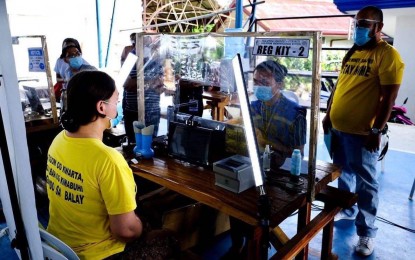
SIGNING UP FOR PHILID. Davao City Mayor Sara Duterte registers for PhilSys at the Barangay Catalunan Grande registration site on March 23, 2021. The Philippine Statistics Authority in Region 11 sees the release of the PhilID this year. (Photo courtesy of the Davao City Information Office)
DAVAO CITY – Up to 1.4 million individuals have already completed Step 1 registration for the Philippine Identification System (PhilSys) in Davao Region as of last year, Philippine Statistics Authority-Region 11 (PSA-11) Director Ruben Abaro, Jr. said Wednesday.
Speaking at a press briefing on April 21, Abaro said of the 1.4 million Step 1 registrants, almost 50 percent or 677,706 are now in the process for Step 2 registration.
Abaro is optimistic the Step 1 registrants would finish Step 2 registration this year and be issued their PhilIDs.
The majority of the Step 1 registrants belong to low-income families, he said, adding PSA will announce as to when registration of the general public begins this year.
As scheduled, PSA targeted low-income households since the beginning of PhilSys registration last year.
“As of now we have not released a PhilID yet, but we are hopeful there will be releasing of IDs this year," Abaro said.
He said Step 2 registration in Davao Region started in February this year.
“We started Step 2 in February and this is in a gradual manner, so slowly we are operating our registration centers,“ he said.
Step 2 refers to the biometrics information that includes iris and photo scanning of the registrants.
Step 1 involves the 10 basic demographic information of the registrants like among others, name, birthday, place of birth, sex, civil status, etc.
The demographic information will be validated in the Step 2 registration.
Step 3 which is the final step involves the releasing of the PhilID and PhilSys Number or PSN. The PSN, which is the registrant’s randomly generated and permanent identification number. PSN contains highly sensitive data and should remain confidential.
PSA earlier said the goal of PhilSys is to give valid proof of identity to every Filipino and foreign resident in the country.
“With the help of having proof of identity, it will be easier for our countrymen to access government and private sector services, and other transactions that require a valid ID,” PSA said.
Signed into law by President Rodrigo R. Duterte in August 2018, Republic Act 11055, or the Philippine Identification System Act, aims to establish a single national ID for all Filipinos and resident aliens.
The national ID shall be a valid proof of identity that shall be a means of simplifying public and private transactions, enrollment in schools, and the opening of bank accounts.
It will also boost efficiency, especially in dealing with government services where people will only need to present one ID during transactions. (PNA)
